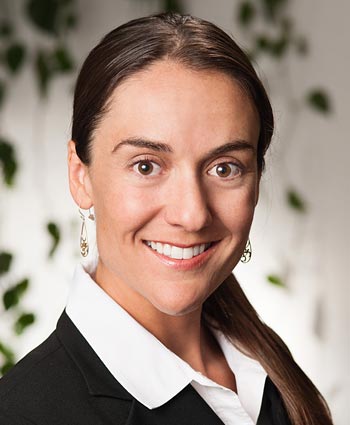Q&A with Kristen Ardani: From Research to Rooftops

As the program lead for Solar Data, Analysis, and Tools in the Integrated Applications Center, Kristen Ardani is making widespread solar deployment a reality. She uses her background in quantitative methods, data analysis, and international relations to identify opportunities for photovoltaic (PV) system cost reduction and pathways for distributed energy resources (DER) to provide value to the grid. She is the principal investigator for the Solar Energy Innovation Network, an NREL-led and U.S. Department of Energy-supported initiative to advance cutting-edge solutions for a more reliable grid. Kristen sat with us to answer some questions about her research. The following has been edited for length.
What has been your main line of work recently?
Our team has been tracking the hardware and non-hardware costs of installing PV for several years and have found that PV hardware costs have declined much faster than non-hardware costs. By non-hardware costs I am referring to items such as permitting, interconnection, customer acquisition, marketing, etc. To identify opportunities to accelerate non-hardware cost reduction, we completed a study which benchmarks the potential cost savings associated with installing PV at the time of new construction and at the time of roof replacement. Our recent cost reduction roadmap analysis, found that there’s significant opportunity to reduce non-hardware costs when installing PV on new construction, which has significant implications for the emergence of new business models and partnerships between construction, roofing, and solar industries.
How does this work end up in the hands of people who will make this market transition happen?
We have been making a concerted effort to broadly disseminate NREL’s solar analysis work and ensure its relevance to stakeholders. For example, for the cost reduction roadmap analysis I mentioned, we partnered with external organizations to disseminate this work at both solar and non-solar conferences. Breaking out one’s typical network is important when trying to reach a diverse audience. After all, we want NREL’s analysis findings to be impactful and useful.
What’s a common challenge to reducing solar non-hardware “soft” costs?
One challenge is the lack of uniformity in interconnection and permitting requirements. With more than 190 investor-owned utilities, 2,000 publicly owned utilities, and 870 cooperatives in the United States, PV developers encounter wide variation in interconnection fees and requirements, which can increase the time and cost of project completion. The lack of standardization in building permitting and inspection processes across more than 18,000 authorities having jurisdiction can further slow PV deployment. From an analysis perspective, it can be difficult to attain the data necessary to capture the added cost of varying requirements given the wide range and geographic diversity.
What about the barriers to installing solar plus storage?
Many industry experts have pointed to the market for solar plus storage systems in the United States and compared it to the standalone PV market 10 or 15 years ago. Some of the permitting and regulatory challenges are similar. To understand the costs of installing a residential PV plus storage system, our analysis team adapted a well-established methodology for benchmarking standalone PV systems to PV plus storage. The paper we authored last year provides a granular cost analysis for varying configurations of residential PV plus storage systems. Interestingly, reported technology costs have fallen and new innovations have come to market since publishing this work, indicating how rapidly the market is advancing and evolving.
Let’s switch to your other big project, the Solar Energy Innovation Network (SEIN). Why is the networked approach effective in this project?
Through the Innovation Network, we have an opportunity to engage with state and local entities in a new and exciting way. First, we are leveraging NREL’s unique analysis capabilities to deliver data to teams comprised of states, localities, and utilities for pilot design of emergent PV integration approaches and planning. Then, we are using a series of outreach and engagement methods to foster cross-learning across stakeholder teams working to address similar challenges. For example, we are working with city of Orlando and the city of San Diego to identify opportunities for PV plus storage deployment on municipal buildings. Each city has very similar questions that they’re addressing and through this project they can share lessons learned while gaining access to the information provided to other participant teams in the network. Lastly, we are focusing on replication and ensuring that key findings from this project are not limited only to direct Innovation Network participants.
What’s an outcome of the SEIN that you’re excited about?
There are many exciting aspects of the Innovation Network. For example, NREL is developing a set of standard electric vehicle load profiles that researchers, utilities, and others can use. We will offer data sets that can be downloaded along with an intuitive user interface. These are resources that will be publicly available and useful to the specific project goals of Innovation Network teams.
What interests you at the moment?
I’m really excited to keep researching new business models and approaches for DER integration. Over the course of Fiscal Year 2018, our team began investigating DER aggregation and peer-to-peer transactive energy models. We will soon be publishing a series of case studies that focus on DER aggregation and distributed energy resource management system implementation. This has been a fascinating area of research with potential to inform the emergence of an entirely new energy system paradigm that ruptures traditional boundaries between electricity consumers and producers, retailers and wholesalers, and dynamic and static pricing.
Last Updated May 28, 2025
